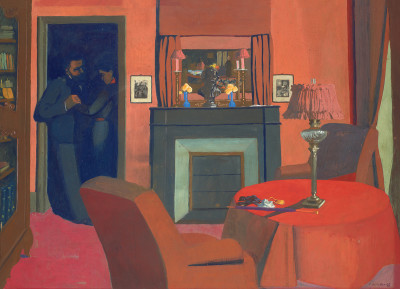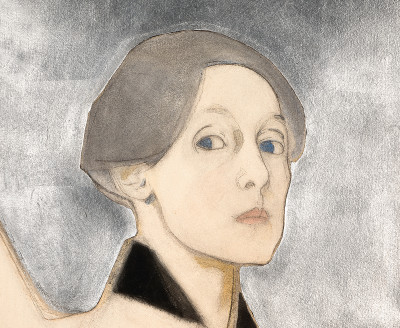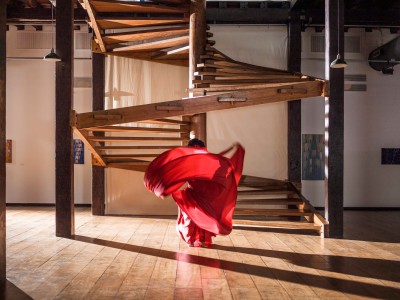Exploring Finland in the footsteps of Helene Schjerfbeck
Exploring Finland in the footsteps of Helene Schjerfbeck
By Sam Phillips
Published 30 May 2019
To coincide with our exhibition of works by Helene Schjerfbeck, Sam Phillips returned to the places the Finnish artist called home, and along the way saw what Finland’s art scene had to offer.
-
From the Summer 2019 issue of RA Magazine, issued quarterly to Friends of the RA.
-
Before visiting Finland for the first time, one thinks of majestic landscapes: untouched forests, the wilderness of Lapland, lakes frozen over. But what becomes clear during even a short holiday is how the nation’s natural beauty is complemented by a rich culture, including great art that has remained largely unknown to the rest of the world. The painter Helene Schjerfbeck, a Finnish national icon whose work has long been overlooked elsewhere, is a case in point. The subject of a show at the RA this summer, her extensive career offers us a way to discover Finland’s larger artistic landscape, beckoning us to the country now the snow has melted and days are long.
Schjerfbeck was a child prodigy, partly due to misfortune: she broke her hip at the age of four and, bedridden, spent much of her convalescence drawing. In 1873, only 11 years old, she was admitted to the prestigious Drawing School of Helsinki’s Finnish Art Society. The school took up residence in 1887 in the Ateneum, a neo-classical building that also housed the Art Society’s fine art collection, as well as the school and collection of applied art. Today the Ateneum Art Museum showcases works from the national collection, from the 19th century to the 1970s. It remains the first stop in a journey to understand modern Finnish art, including Schjerfbeck’s work – it provides many of the loans in the RA’s show, a version of which it presents this winter (15 November–26 January 2020). The Ateneum’s exhibition this summer, Silent Beauty (14 June–6 October), explores post-war connections between Nordic and East Asian art.
-

Helene Schjerfbeck, The Convalescent, 1888.
Courtesy Finnish National Gallery/ Ateneum Art Museum, Helsinki.
-
Finland did not become an independent country until 1917. It had been annexed by Russia in 1809, after centuries as part of the Kingdom of Sweden. Swedish art, particularly portraits, form a central part of the national collection of European Old Masters at the Sinebrychoff Art Museum; its summer show Heavenly Colours – Blue and Gold shows how painters combined these potent tones (until 25 August). Trends in European art, and especially Naturalism from France, initially shaped Schjerfbeck’s work; after four years at the Drawing School, Schjerfbeck learned oil painting in the private academy of Adolf von Becker, a genre painter of German descent who had been one of the first Finns to study in Paris.
Now on the walls of the Ateneum, her early breakthrough work Wounded Warrior in the Snow (1880) was a poignant scene, inspired by stories of the Swedish-Russian War, of a soldier dying alone in a wintery landscape. Its contemplative tone offered relief from the heroic bombast of paintings of war produced by male artists, and marked Schjerfbeck out as a talent. A travel grant from the Senate of Finland followed, taking her to Paris and kickstarting a period of foreign travel that lasted for more than a decade. She joined artist colonies in Brittany and St Ives, where, alongside more conventional canvases, she experimented with a looser handling of paint and pared-back composition. She also worked briefly in Florence, Vienna and St Petersburg, absorbing the lessons of the Old Masters. Back home, Schjerfbeck’s idyllic landscapes in southwest Finland included those of Sjundby Manor, a medieval estate owned by her relatives that she visited often in her youth.
At home and abroad Schjerfbeck befriended female artists, including Helena Westermarck and Maria Wiik. Now known as the ‘painter sisters’ generation, these Finnish female artists gave vital support to each other’s practice in a man’s art world. Perhaps the most radical Finnish female painter of Schjerfbeck’s lifetime, other than Schjerfbeck herself, was Ellen Thesleff; her expressionistic work, which embraced abstraction, is celebrated in a solo show at the Helsinki Art Museum until 26 January 2020.
-

Amos Rex Museum in Helsinki
© Tuomas Uusheimo
-
In 1888, while Schjerbeck was staying in St Ives with another friend, Marianne Preindlsberger, and her husband, British artist Adrian Stokes RA, she completed The Convalescent (above). It was accepted by the Paris Salon and is now one of the Ateneum’s best-loved paintings. It is perceived as something akin to a self-portrait, due to the artist’s childhood illness and her recovery, at the time it was painted, from a broken heart. On other walls of the museum one can see how her compatriots, notably painter Akseli Gallen-Kallela, turned their focus instead to national identity, taking Finnish folklore as subject matter as a way to break from academic tradition. Further strands in modern Finnish art can be seen in the capital in the post-impressionist Sigurd Frosterus Collection, on permanent display in Amos Rex, a museum worth visiting for its futuristic subterranean building alone (above).
Schjerfbeck’s own radical shift came in relative isolation, after a downturn in her career and ill-health led her to leave Helsinki for Hyvinkää in 1902. In this small town much of the artist’s time was dedicated to looking after her elderly mother; she did not visit the capital for more than a decade, instead connecting with the art scene by reading magazine articles and corresponding with friends. Today there is not much to see in Hyvinkää relating to Schjerfbeck, bar the local Hyvinkää Art Museum that includes a handful of her paintings, all fairly minor – if you do visit, it is worth taking the train on to Riihimäki, where an interesting mix of modern Finnish art is on view at Riihimäki Art Museum. But it was during her Hyvinkää period that Schjerfbeck developed her style of figurative modernism. Making portraits either of herself, her mother or neighbours, she began to omit superfluous details from her paintings (Maria, 1909; below), reworking her representations until she had reduced them to essential elements: graphic edge, geometry and glowing colour. Paint was layered and then wiped out, with the bare canvas often exposed to delineate shape.
-

Helene Schjerfbeck, Maria, 1909.
© Finnish National Gallery / Ateneum Art Museum, Helsinki.
-
In 1925, two years after her mother died and now becoming elderly herself, Schjerfbeck moved to the coastal town of Tammisaari (Ekenäs, in Swedish; below), a place of wide skies and happy childhood memories. She pushed her art further, her self-portraits becoming ghostly, even violent, in tone and outline as she. The town’s EKTA Museum has a floor dedicated to her paintings and drawings, and features items of furniture, sketchbooks, one of the textile works she produced and even her cane. A local actor, Anne Ingman, organises dramatic tours of the town in which she assumes the dress and character of Schjerfbeck; it culminates in the local park overlooking the water, where the artist would often paint. Here the Norwegian contemporary artist A.K. Dolven has installed a large copper church bell, suspended amid the trees, as a memorial to Schjerfbeck. On pulling its wooden lever, a single, sorrowful chime sounds.
Helsinki’s Hietaniemi Cemetery, the most significant in Finland, is Schjerfbeck’s final resting place, among the graves of other revered artists such as Akseli Gallen-Kallela and Tove Jansson. Schjerfbeck died in Sweden in 1946, but not in obscurity. Before she moved to Tammisaari, her experimental modern works had been discovered by art dealer Gösta Stenman, who staged successful solo shows of her work in Helsinki and Stockholm.
-

The old town of Tammisaari (Ekenäs), where Schjerfbeck lived from 1925
Photography by Kjell Svenskberg
-
In a beautiful spot beside Laajalahti bay on the outskirts of Helsinki, Villa Gyllenberg shows the many Schjerfbecks acquired by the collectors Signe and Ane Gyllenberg, alongside their Old Masters and a temporary exhibition of Finnish landscapist Sigrid Schauman (until 4 August). Another private collection is close by, at Didrichsen Art Museum, where 20th-century Finnish artworks, including a selection of Schjerfbecks, meld with those by figures such as Picasso, Kandinsky and Henry Moore.
From Didrichsen, one can take a bus into the satellite city of Espoo, followed by a short walk to Espoo Museum of Modern Art, housed in a Brutalist building and showing ambitious international contemporary art; its latest exhibition, Interwoven, (5 June–1 March 2020) threads together art and textiles.
It takes around two hours by train from Helsinki to reach Turku, where Turku Art Museum gives a great overview of Finnish art, including superb Schjerfbecks, with a summer show spotlighting the 20th-century American photographer Imogen Cunningham (7 June–15 September). Heading north from the capital takes you to Tampere, and the Moomins Museum, a magnet for fans of Tove Jansson’s comic-strip characters, and the modernist structure of the Sara Hildén Art Museum that overlooks Lake Näsijärvi. If you are staying in Tampere, take a day trip, via shuttle bus, to Mänttä’s Serlachius Museum (below), which presents its superb collection of historic Finnish art alongside daring contemporary art shows.
-

Serlachius Museum, Mänttä
Photography by Olli Huttunen
-
How much does Schjerfbeck’s example echo in Finnish art today? Back in Helsinki, a visit to the Finnish National Gallery’s museum of contemporary art, Kiasma, can help us answer. Many artists, certainly, seem to share Schjerfbeck’s intense interest in identity and self-representation. The museum presents a solo show by Iiu Susiraja (until 28 July), who commits to self-portraiture with a dedication that Schjerfbeck would be proud of – if also a little bemused. With a healthy dollop of Nordic humour Susiraja’s photographs show her in ordinary situations holding everyday items as absurd props. The natural world also remains a magnet for Finns and is explored in Kiasma’s group show Coexistence (until 1 Mar 2020).
But perhaps Schjerfbeck’s spirit is one that permeates all serious artists: an independent outlook underpinned by indomitable will, allowing them to face the difficulties of art – and life – without turning away.
Sam Phillips is Editor of RA Magazine. For more information on visiting Finland see visitfinland.com
-
-
Enjoyed this article?
Become a Friend to receive RA Magazine
As well as free entry to all of our exhibitions, Friends of the RA enjoy one of Britain’s most respected art magazines, delivered directly to your door. Why not join the club?

-









